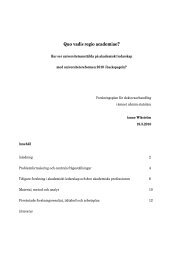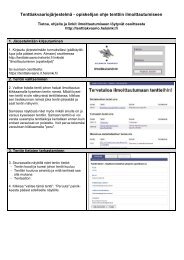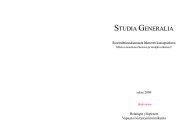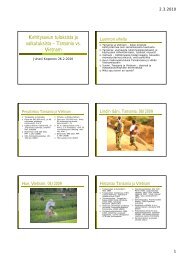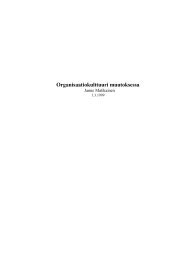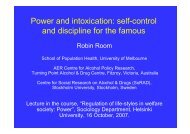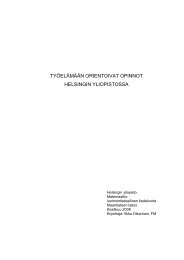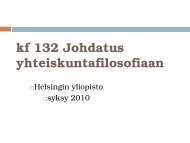Ambio, Vol. 27, No. 2, pp. 112-117
Ambio, Vol. 27, No. 2, pp. 112-117
Ambio, Vol. 27, No. 2, pp. 112-117
- No tags were found...
Create successful ePaper yourself
Turn your PDF publications into a flip-book with our unique Google optimized e-Paper software.
Royal Swedish Academy of SciencesInstitutions, Environmental Management and Long-Term Ecological SustenanceAuthor(s): Janne HukkinenSource: <strong>Ambio</strong>, <strong>Vol</strong>. <strong>27</strong>, <strong>No</strong>. 2 (Mar., 1998), <strong>pp</strong>. <strong>112</strong>-<strong>117</strong>Published by: Allen Press on behalf of Royal Swedish Academy of SciencesStable URL: http://www.jstor.org/stable/4314696Accessed: 04/12/2009 09:41Your use of the JSTOR archive indicates your acceptance of JSTOR's Terms and Conditions of Use, available athttp://www.jstor.org/page/info/about/policies/terms.jsp. JSTOR's Terms and Conditions of Use provides, in part, that unlessyou have obtained prior permission, you may not download an entire issue of a journal or multiple copies of articles, and youmay use content in the JSTOR archive only for your personal, non-commercial use.Please contact the publisher regarding any further use of this work. Publisher contact information may be obtained athttp://www.jstor.org/action/showPublisher?publisherCode=acg.Each copy of any part of a JSTOR transmission must contain the same copyright notice that a<strong>pp</strong>ears on the screen or printedpage of such transmission.JSTOR is a not-for-profit service that helps scholars, researchers, and students discover, use, and build upon a wide range ofcontent in a trusted digital archive. We use information technology and tools to increase productivity and facilitate new formsof scholarship. For more information about JSTOR, please contact su<strong>pp</strong>ort@jstor.org.Allen Press and Royal Swedish Academy of Sciences are collaborating with JSTOR to digitize, preserve andextend access to <strong>Ambio</strong>.http://www.jstor.org
ArticleJanne HukkinenInstitutions, Environmental Management andLong-term Ecological SustenanceInstitutions are the social rules that guide the design ofstrategies such as environmental management. Institutionscan therefore significantly facilitate or hinder the realizationof sustainable development. This paper relies on casestudies of long-term waste management in Finland andCalifornia to explore institutional arrangements thatfacilitate the design of sustainable environmental management.The analytical focus is on the feedback betweeninstitutions and individual perceptions. Institutions influencethe mental models with which individual decision makersunderstand environmental issues, and individual mentalmodels in turn reinforce the institutional context. The mainpolicy implication of the analysis is that long-term environmentalconsiderations should, at the institutional level, bemade the responsibility of independent social bodies thatcould pursue sustainability goals with autonomy andauthority. The paper concludes with a discussion of potentialtechnocratic and democratic modes of establishingautonomy for the long-term sustainability concerns insociety.INTRODUCTIONEnvironmental management, or the means and ends to correctenvironmental problems, is at the heart of the sustainable developmentdebate. Environmental management is subject to complexinteractions among the various components of the biosphereand uncertainty over the precise nature of these interactions. Asif the ecological unknowns were not enough, some of the mostvexing issues are sociopolitical in nature: Environmental managementis intergenerational, transnational, torn by politics between<strong>No</strong>rth and South, and confused by conflicting perceptionsand ideologies (1, 2).This paper explores institutional arrangements that would facilitatethe design of environmental management systems rootedin the principles of sustainable development. Institutions matterto sustainable development, because they are the social rules thatguide the design of environmental management. While theBrundtland Commission's definition of sustainable development(meeting the needs of the present generations without compromisingthe ability of future generations to meet theirs) (3) hasin many ways brought global legitimacy to the principle of sustainabledevelopment, it has not helped environmental policymakers and practitioners operationalize the principle as concreteenvironmental management guidelines. On the contrary, manyanalysts have come to the conclusion that sustainable developmentis impossible to operationalize in any stable way due toits inherently political and dynamic nature (2, 4).The volatility of the concept of sustainable development doesnot, however, invalidate the objective to search for institutionalconfigurations that lead to sustainable development. After all,many other equally popular and volatile concepts, such as democracyand justice, have proven powerful shapers of modemsocieties. It is precisely the socially-grounded nature of sustainabledevelopment that makes the institutional design so important.From the institutional perspective, the practical challengefor a given society at a given point in time is not to find a scientificallyobjective definition of sustainable development, butto develop institutions that enable the society to reach a legitimateconsensus on what sustainable development means andhow it should be operationalized.I examine the institutional issues of environmental managementthrough two case studies: (i) the formulation of long-termhazardous waste-management policy in Finland in the 1990s; (ii)the management of toxic irrigation drainage in Central Californiain the 1980s. The cases were chosen on the basis of similaritiesin the characteristics of the environmental problem andthe theoretical and methodological a<strong>pp</strong>roaches taken to analyzethe problem.The environmental problems the two cases deal with havesimilar spatial, temporal and causal characteristics. The spatialareas in both studies are large and contain diverse ecosystems.Hazardous waste-management system relies on a centralizedplant that treats much of Finland's 338 000 km2 hazardous wastesat a single location in southern Finland. In California, irrigatedfarmland in the San Joaquin valley covers just 19 000 km2, butthe complex water conveyance system transmits the impacts ofirrigation and drainage throughout most of the 411 000 km2 ofthe state and, in fact, beyond its borders to most of the arid westernUnited States. Both cases deal with a time scale of centu-ries. Analysis of Finland's waste-management strategies 'looksahead' by offering an explanation for the considerable difficultiespolicy makers face when attempting to prepare environmentalpolicies covering several decades. California's drainage managementcase 'looks back' by illustrating what can ha<strong>pp</strong>en whena gradually developing environmental stress is left unheeded formore than a century, and then suddenly awakened to politicalurgency when ecosystem resiliency is used up. Finally, bothcases are characterized by complex and poorly understood causeand-effectrelationships relating to efforts to prevent the releaseof toxic substances into the environment (5, 6).The theoretical and methodological a<strong>pp</strong>roaches are also similarin the two cases. Both cases rely on the social constructionistnotion that most of today's environmental management dilemmashave less to do with deficient or unreliable information andmore with profoundly different conceptions among stakeholdersof what constitutes the environmental problem (7). To determinethe differences in thinking, the mental models by which key decisionmakers and experts understand the environmental problemwere ma<strong>pp</strong>ed and analyzed. Finally, policy recommendationsin both cases are based on institutional theory about thefeedback between individual mental models and social institutions(8).Figure 1. Feedback between mental models and environmentalinstitutions.Environmental officialexperiences increasig .tocognitive dissonance.Environmental officialreduces cognitivedissonance by adheringto prevailing institutionalrules.Institutional pressureachieve short-termeconomic benefitsincreases.<strong>112</strong> ? Royal Swedish Academy of Sciences 1998 <strong>Ambio</strong> <strong>Vol</strong>. <strong>27</strong> <strong>No</strong>. 2, March 1998http://www.ambio.kva.se
I introduce some of the institutional economic concepts theanalysis relies on. The reader should keep in mind that the mainpurpose is to illustrate the dynamics between institutions and individualperceptions in long-term and large-scale environmentalmanagement. However, since the two cases represent quitedifferent sociopolitical and cultural contexts, yet converge ontheir broad institutional characteristics, one should look for similardynamics in other large-scale environmental managementsystems (9). According to the cases, the absence of institutionsthat would allow autonomous social agents to decide on longtermenvironmental management has committed western indus-trialized countries to an industrial production system incapableof ecological restructuring and waste prevention.MENTAL MODELS AND INSTITUTIONS OFENVIRONMENTAL MANAGEMENT<strong>No</strong>rth (8) explains the society as a game played by social organizationsaccording to the rules stipulated by institutions, bothformal (such as laws and regulations) and informal (such asnorms, customs and habits) (8). Organizations devise plans, policiesand strategies to survive or win in the game. To a neoclassicaleconomist, the outcome of the game is determined by playerpreferences and market forces. In light of historical evidence,however, institutions determine how freely individual economicactors can express their own views, which may result in verydifferent outcomes to the game from those predicted by neoclassicaleconomics and public choice theory alone. Institutions persistdue to a lock-in, or reinforcing feedback, between them andindividual perceptions. The institutional framework determineswhat organizations come into existence and how they evolve,but the perceptions of individuals working in the organizationsalso influence how the institutional framework evolves (Fig. 1).The two cases described illustrate the feedback between institutionsand perceptions. The policy makers interviewed, frequentlyexpressed the need to take into account the long-termfuture in environmental management, but the institutional frameworkwithin which they operated was a disincentive for them todevelop and implement environmentally sustainable policies.Increasing returns on initial resource commitment in environmentaltechnology and the complexity and uncertainty of longtermenvironmental issues reinforce the short-run oriented institutionalcontext. While the specific policy outcomes differ in thetwo cases, the cognitive structure that the policy makers and expertsshare is cognitive dissonance, i.e. an inconsistency betweenindividual decision makers' goals (policies they think shouldguide decisions) and operating assumptions (policies they thinkwill guide decisions) (10).In the two cases, cognitive dissonance takes the form of a tensionbetween goals emphasizing long-term ecological sustenanceand operating assumptions aiming at short-term economic profit.Cognitive dissonance is not merely the occurrence of conflictbetween the values of an individual official and the values onwhich the policy of the agency employing the official is based.It is rather a conflict between two very different knowledges thatthe official holds about him/herself and his/her surroundings:One relating to the state of affairs the official would like toachieve in the social game, the other to what the official considersachievable in the game under existing constraints. As thetheory on cognitive dissonance would predict, the profit-orientedoperating assumptions that dominate both the Finnish and Californiansocieties exert large enough pressure on the official topersuade him/her to reduce the dissonance by deciding on thebasis of short-term economic considerations (10). Put it anotherway, the price-be it in the form of diminished prestige or lostposition-that the individual official would have to pay for decidingaccording to his/her honest professional beliefs is too highIO\Acting in accordance with the predominant assumptions of thesurrounding society does not, however, erase the cognitive dissonancethe official experiences. Quite the o<strong>pp</strong>osite, it exacerbatesthe conflict between what the official believes in and whathe/she knows to be the necessary course of action. The cognitivedissonance individual decision makers experience and theprofit-oriented institutions surrounding them are thus in a mutuallyreinforcing feedback. The stronger the pressure that institutionsput on an individual decision maker to achieve shorttermeconomic benefits, the more pronounced the cognitive dissonancethe decision maker experiences; but the more pronouncedthe cognitive dissonance, the stronger the individual'sneed to reduce the dissonance by adhering to the prevailing institutionalrules (Fig. 1).INSTITUTIONAL OBSTACLES TO LONG-TERMECOLOGICAL SUSTENANCEHazardous Waste in Finland and the Social Steering ofEnvironmental ManagementFinland's hazardous waste-management problems have much todo with the country's large land area and small population, whichhave resulted in many small landfills (a total of 680 in 1990).Many have been closed down, but this has not diminished concernsthat the closed landfills may in fact be environmental crisesin the making as a result of hazardous wastes received dur-ing the country's rapid industrialization since the 1950s (11). Thesituation improved considerably in 1984 when the nation's centralizedhazardous waste-management plant, Ekokem, began itsoperations. When this case study was conducted in the early1990s, a total of 233 000 tonnes of hazardous waste was generatedin Finnish industry, of which a<strong>pp</strong>roximately 100000 tonneswere recycled as raw material, 90 000 treated at wastewater-treatmentplants and 43 000 treated or stored otherwise. Of the 43000 tonnes, 52% ended up at Ekokem (12).The case example on Finnish hazardous waste managementcomes from a larger study conducted from 1991 to 1993 on waysto improve the capacity of Finnish policy makers to design andimplement long-term waste-management strategies (13, 14). Thestudy focused on scenarios, or mental models, with which 24decision makers and experts on Finnish waste management rationalizetheir long-term decisions. Individual mental modelswere treated as equal elements of a collective and often internallyinconsistent model of the future. Analysis of the factual,attitudinal and logical inconsistencies in the mental models indicateshow institutions constrain policy decisions and what institutionalchanges might enable policy makers to better preparefor the long-term future (15).The interviewees described what they believed to be futurewaste-management problems in complex narratives characterizedby numerous cause-and-effect relationships. For analytical purposes,the causal dependencies between problems were codedas directed node-and-link graphs. <strong>No</strong>des in the graph are problemstatements, or sentences describing a future waste manage-ment problem. Links represent those parts of a narrative that indicatea causal relationship between two problem statements (16,17). Network representation makes explicit the linkages thatmight easily be overlooked in the narratives and allows the analystto consider the implications of several individual mentalmodels in the aggregate. The interviewees disagreed over whatthey believed to be central waste-management challenges in thefuture. <strong>No</strong> less than 282 different problem statements were identifiedin the 24 interviews.The Finnish case illustrates problems that arise when the regulationand implementation of environmental management areconfused. The Ministry of the Environment in Finland is thechief regulator of the nation's hazardous waste management, but<strong>Ambio</strong> <strong>Vol</strong>. <strong>27</strong>, <strong>No</strong>. 2 March 1998 ? Royal Swedish Academy of Sciences 1998 113http://www.ambio.kva.se
[also owns a third of Ekokem, which is in a monopoly position.The Ministry's representative sits on the company's board of directors.The regulators' involvement in implementation has hadshort-term advantages. It helped overcome the political o<strong>pp</strong>ositionto the construction of Ekokem in southern Finland in theearly 1980s. It also guaranteed Ekokem's regulatory complianceduring the first decade of operation (18). But the interviews indicatethat Ekokem is tra<strong>pp</strong>ed in a cycle of first designing excessdisposal capacity, only to discover the capacity to be inadequatewhen environmental regulators order more waste to bedisposed at Ekokem. Circular argument 3 by interviewee 1 (presentedas a problem network in Figure 2) exemplifies the dilemmathat hazardous waste-management officials find themselvesin.The regulators were found to be in a cognitive double-bind.If their only goals were short-term monetary ones, Ekokem's diminishingprofits would not be a problem, because hazardouswaste could be left to the market to handle. If sustainability goalswere the only relevant ones for the regulators, they might viewthe disa<strong>pp</strong>earance of Ekokem as a signal of the beginning stagesof industrial ecology. However, the simultaneous requirementof short-term economic profit and long-term ecological sustenanceputs regulators in a dilemma. Without significant investmentin research and development, nothing can guarantee thatmarket-based hazardous-waste management will also be environmentallysound, or that firms operating with industrial ecologywill also be profitable. In the end, officials opt for profitmaximizingoperating assumptions that allow Ekokem to expandprocess capacity (Fig. 2).Yet the individual regulator is not to be blamed. The shorttermenvironmental policy emanates from the institutional arrangementand does not reflect an individual regulator's lack ofcommitment to sustainable development. He or she has simplymade informed choices under the boundary conditions of thepolicy machinery. Policy makers in hazardous waste managementoperate under considerable cognitive dissonance over whatthey think ought to be the environmentally sustainable policy andwhat they tiink is the feasible environmental policy.Administrative merging of regulation and implementation seriouslyweakens the Ministry's ability to set long-term wastemanagementpolicy. The interest to keep Ekokem viable in mon-Figure 2.Conflict between Ekokem is designed CircularwastereduUon ad .4 and redesigned tohave excesof argument Finnishdisposal is polarized.1 1 1 1officials direct morewaste wastenvikoneme to Ekokem.HEkokem receives socanno much waste itmcannot incinerateall of it.managementofficials.etary terms in the short term, will in the long run impede policiesthat encourage investment in clean technology. Althoughthe plant has operated reliably to date, the ageing technology maymalfunction in the coming decades. Such an event could rapidlyerode the public credibility of the Ministry, which wouldfind itself in the awkward position of passing regulatory judgmenton the soundness of its own emergency response, at its ownplant. The impacts of and barriers to the main policy options inFinland's hazardous-waste management are summarized in Table1.Agricultural Drainage in California and the OperationalControl of Environmental TechnologyRecent efforts to manage agricultural drainage problems in oneof the world's most productive agricultural areas, California'sSan Joaquin valley, provide insights to the way the organizationof technology can hinder long-term decisions. More than 300000 ha of the 1.9 mill. ha of irrigated farmland in the valley arethreatened by drainage problems, including waterlogging,salinization and toxicity. The valley's waterlogging andsalinization problems are due to an underground layer of clay,which restricts the drainage of irrigation water. As a consequence,large-scale irrigation has led to high water tables andsalt accumulation. In addition, naturally occurring but potentiallytoxic trace elements have been found in drainwater (19, 20).Subsurface drains have been constructed to remove the saltydrainwater from beneath the agricultural fields. Over the past;Uz f. z f:f, z zz t n:f'!'..::z!M,;;',M _,z .. .. .. ...... n f; n ss zz!;.z z, ! s,: ............. . ........ .. t s: M t' :s; X nt M tt s; s ti ff s: = 14 z M : U : f: :" tn f......... ... .... ........... ..... .. . .. . .. .... ... .......... - - ..."...U .-11...&.;;': ::f4;'- ;:: : ! .1U11 ... .... ....... ... . ..n= uns"U 4V t =Xn........ ..................... ... ................ tt fsma....................... .......... ............ ..........MURS;- H.: F .11...............r: f;jn;,-. ......................f t t t s ;t f f sMat;ziIi Nfstfs.................f t n2:; n= NU,:...........U=t1.111 ... ... . . . .... M...........M :t................ . .............t ............. .... .......fx 3;:;!;:;. ..................... ....HUu==;UZ...........tiunsP.s:. ........ ......... ............. ... . .............7v tm : x n: t t M f.,ttfatMt f.. ............... . ........... nsm , fm :Xt, f;; i. f: 41 fs; f: M : s; u: s n:-N -jf............ ...... .... ........................ ;::.s;:t,,;::.:::tf;:,,:;t.fs:7:;:ts,:4;;tff;tff;u:.fit4fs":f4 ............. .............. ......... . ......!s;m sm f........... .......... ............. USU'f::= :::tff;ttf;;i:;ii;lttfs."tf.si::f"n",: . ........u uts; m !- : s; n4s; ........ .. .............. .........................................tg:.111-1 ..................... .... ....sntM : = f" 1t.. ......... ......;N,4MIM;.. f:4'- .......................... .ul;uwfuu. ttt ftUntup=-.1- fM. ffMlf=:.......... ............... . ..x=A =s K............fs t7' t;: si Mf'fti" nf.4 Xls,,:fz=s',M f=iM ... ................................ ........ fs"X: V M V: f M U U:t ............... ........2:XIr4 ss UtU t r t=i V!n X V- t: f?-:: I u=s Mi ff t f3:=:tv114 Royal Swedish Academy of Sciences 1998http://www.ambio.kva.se
three decades, one governmental study after another found amaster drain either to the San Francisco Bay-Delta or directlyto the Pacific Ocean to be the best way to dispose of the drainagein the long run (21-24). As the master drain has not beenconstructed, agricultural wastewater has been discharged into theSan Joaquin river or evaporation ponds in the valley. The concentrationof toxic elements in evaporation ponds has led to fishand bird deaths and deformities. Concerns over the potentialdamage that drainage might do in California's ecologically sensitivecoastal areas has made out-of-valley options, such as themaster drain, politically unacceptable to virtually all interestgroups. Attention has shifted to assessing on-farm management,land retirement and various treatment processes. These, however,involve untested technologies and do not guarantee a long-termsalt balance in the valley (25).Legal and contractual responsibility to manage agriculturaldrainage in the valley rests with federal, state and local agencies.However, their primary concern has historically been to securethe viability of agricultural production through the storage,conveyance and distribution of irrigation water to farmers. Drainagehas always been considered a secondary, long-term goal bythese agencies.My co-workers and I began to study California's drainageproblems in 1987, when the toxic discoveries had transformeddrainage from a secondary and distant issue into irrigation officials'primary concern requiring urgent remedies. In 23 interviews,we discovered 90 different and often conflicting technical,economic, social, legal and organizational descriptions ofthe San Joaquin valley drainage problem. As in the Finnish case,the focus of analysis was on the controversy's fundamentalackof convergence over how problems and their causal relationshipswere defined (26, <strong>27</strong>).The interviews indicated that California's irrigation officialsfaced a cognitive dilemma. Efforts by irrigation officials to effectivelymanage drainage, most of all by constructing a masterdrain, would secure agricultural production. But such attemptswould also raise strong o<strong>pp</strong>osition from the environmental communityand urban tax-payers against toxics management and subsidizedirrigated agriculture. <strong>No</strong>t managing drainage would moderatethe political criticism, but eventually lead to extensive landretirement and toxicity problems. Irrigation officials hadcognitively internalized the conflict. Despite their preference fora long-term solution for the entire valley, the officials a<strong>pp</strong>easedtheir critics by publicly announcing no such solution was possible.An example of the internalized conflict is the circular argumentby California's irrigation officials, which is held togetherby the view that both land retirement and efforts to alleviate theeconomic hardships resulting from land retirement are problematic(Fig. 3).As a result of their uneasy walk between avoiding polarizedconflict and reducing the uncertainties of drainage management,irrigation officials could only incrementally manage drainagethrough various short-term remedies. For example, the governmentalSan Joaquin Valley Drainage Program, which investigatedthe problem throughout the 1980s, originally claimed todevelop comprehensive plans for long-term management ofdrainage problems, and recognized that the problems could notin the long run be solved solely in the valley (20). At the sametime, the Program's management and advisory committees directedits staff not to study out-of-valley drainage disposal, whichearlier reports had found to be the only viable long-term solution(28). The irrigation officials' dilemma was found to governevery aspect of drainage management in the valley, fromplanning and design of on-farm irrigation management to resourcemobilization for the decommissioning of toxic evaporationponds (29). The impacts of and barriers to the main policyoptions in California's drainage management are summarized inTable 2.1Figure 3.Land must goBusiness competition Circularbetween large and argument ofout of production. small farms. California'sirrigationofficials.Need to compensatefarmers going out ofbusiness due todrainage problems.Equity problems:who benefits,who pays?TOWARD INSTITUTIONAL REFORMIn both the Finnish and the Californian cases, the institutionalrules of environmental management impose fundamentally conflictingpolicy imperatives upon individual policy makers, whoin turn lack the autonomy to settle the conflict in accordance withtheir honest beliefs. Officials, managers and experts interviewedin the case studies all expressed a clear preference for practicingecologically sustainable management. However, under existinginstitutional boundary conditions, they felt compelled to adhereto localized, short-term and profit-oriented operating assumptionsin policy implementation. Policy makers and managers 'resolved'the resulting dilemma with the cognitively dissonant positionof preaching long-term sustainability while practicingshort-term economics.The unfortunate policy outcomes of the dilemma are slightlydifferent in the two cases. When the environmental issue at handis perceived to be acute, as in the San Joaquin valley drainagecase, policy makers opt for research, development and other suchactivities that give the general public the impression experts aredoing something about the problem. At the same time, they avoidaction-forcing long-term decisions that might raise potentiallydevastating questions about the rationale of continuing an eco-nomic activity that causes serious environmental problems in thefirst place (Table 2). When the environmental issue is not acute,as in the case of Finland's hazardous-waste management, policymakers turn completely away from the issue of long-term environmentalmanagement. Instead, they focus on refming technologiesand administrative procedures that ensure compliance withenvironmental regulations in the short run, but also guaranteethe persistence of a wasteful industrial infrastructure (Table 1).One way of breaking the myopic lock-in between institutionsand mental models is to rewrite the institutional rules in a waythat awards policy makers the autonomy to act upon their be-liefs. In the California case, this would mean administrative separationof the responsibility to manage drainage from the responsibilityto provide irrigation water. Analogously, the prerequisiteof far-sighted waste-management strategy in Finland wouldbe distinct decoupling of implementing and regulatory powers.In practice, this could be achieved either by reallocating authorityamong existing agencies or by creating completely new ones.Administrative decoupling of conflicting interests would haveseveral advantages. (i) It would remove the cognitive basis ofshort-sighted decisions by allowing policy makers to freely crafttheir operating assumptions to match sustainability goals, howeverthey choose to define them. (ii) Administrative autonomywould allow policy makers to actually pursue the sustainabilitygoals without fearing loss of organizational autonomy or professionalposition. (iii) Organizational independence wouldshield policy makers formally devoted to sustainability principlesagainst public criticism about lack of vision, which they areso exposed to when operating under conflicting policy imperatives.The proposed reforms would not make environmental conflictsdisa<strong>pp</strong>ear. Tensions would continue both within the new 'sus-<strong>Ambio</strong> <strong>Vol</strong>. <strong>27</strong>, <strong>No</strong>. 2 March 1998 ? Royal Swedish Academy of Sciences 1998 115http://www.ambio.kva.se
tainable development' agency and between the new and existingagencies. But the internal conflicts would be less severe andthe external ones more manageable than before. Within the newagency, experts of different sectors of environmental protectionwould naturally have diverging opinions of what should be doneto move toward sustainable development. But this sort of professionalargument over the means to achieve ends is the normin any government agency. The point of administrativedecoupling is to transform the pull between long-term environmentalconcerns and short-term economic ones, which provedso elemental in sustaining the officials' decision-making dilemmain the two cases, from a conflict within an agency into aconflict between agencies. For such conflicts, there already existresolution mechanisms, such as negotiation, arbitration andthe courts.The recommendations run against the accepted wisdom ofmany recent panels on global environmental policy, such as theBrundtland Commission and the UN-Rio Conference, which ad-vise the institutional integration of environmental and economicconcerns (3, 30). Yet the decoupling of environmental and economicinterests is by no means extraordinary-it has been notjust recommended, but done before. The separation of irrigationand drainage is nothing less than a divorce between the admin-istrative system of irrigation from the environmentally tuned normativesystem that restricts drainage management. According toHabermas, one way for an organization to avoid a legitimationcrisis in the long run is by decoupling the administrative systemunder threat from the norms that need justification (31).Similarly, the recommendation to make a clear distinction betweenimplementation and regulation is not new. Wilson andRachal, for example, posed themselves the question "Can thegovernment regulate itself?" and discovered the answer wasnegative (32). Furthermore, the principle of creating autonomoussocial agents through institutional design is already much utilized.Institutionally determined autonomy enables judges tomake decisions according to their professional convictions, universityprofessors teach what they believe in and voters vote asthey please, without fearing social sanctions for doing so (8, 33).The creation of autonomous social agents with the mandate tomake long-term environmental policy would therefore be an expansionof an already well-established principle in social organization.DISCUSSIONEach of the two cases reveals a perspective on environmentalmanagement from which competing social interests come intofocus. In the Finnish case, that perspective is the social steeringof environmental management, and the lesson to be learned isthat organizational distribution of regulatory and implementingpowers has significant influence on the outcome of environmentalmanagement. The California case is about the operationalcontrol of environmental technology and shows how ina<strong>pp</strong>ropriateadministration of technology can lead to significant politicaland economic conflicts of interest.But the proposed administrative reforms also raise the spectreof conflict between technocratic rationality and democraticbalancing of interests. What guarantees that the proposed autonomousdrainage agency in California, for example, will not developinto the kind of monolithic power base that many votersin the state think the irrigation bureaucracy today is? What guaranteesthat the values of the experts will represent the values ofthe population at large; that the experts have sufficient knowledgeon issues beyond their expertise; or that the experts canlegitimately resolve the distributional conflicts associated withthe various solutions? Representation and elitism are issues thatalready the early systems theorists tackled with when ponderingthe possibility of allowing a panel of experts to act as a surrogateof future generations (34).While the issue of technocracy versus democracy does not invalidatethe principle of decoupling conflicting interests in environmentalmanagement, it does indicate that the range of a<strong>pp</strong>licationof the design principle needs to be expanded. In thefollowing, I will outline a few reform ideas that are much moredynamic in nature than the administrative changes. To do this, Iintroduce two additional perspectives from which competing socialinterests in environmental management can be identified.Both perspectives overlap with the two earlier ones and are anunderlying theme not just of the two cases but of the past threedecades of environmental issues.The spatial-temporal perspective highlights the fact that themost pressing environmental problems today typically cover geographicallylarge areas and require attention spans over severaldecades, even centuries. The problem is, as both environmentaland biodiversity management analysts point out, that policiesmeeting sustainability criteria for local areas and shorter timescales often fail to do so for larger areas and longer time scales(1, 35, 36). So, too, in the California case. The in-valley agri-cultural management solutions that the latest governmental paneldeveloped were, by the panel's own admission (25), sustainableon a regional level over decades but not for the entire valley overcenturies (Table 2). Another significant perspective is the politicaleconomy of environmental management, which refers hereto the pull between environmental and monetary imperatives.Both laymen and politicians have been found to show compas-sion for the environment and even propose sensible plans to abateenvironmental pollution, but when actual decisions are taken,short-term economic factors override environmental concerns(37, 38). In the Finnish and Californian cases, this tension constitutedthe officials' cognitive dissonance.The institutional design challenge arising from the last twoperspectives is: How to guarantee autonomy to global, long-termand primarily environmental imperatives in the face of localized,short-term and primarily economic demands? A workable startingposition is to respect one of the fundamental findings of institutionaleconomics and economic history, namely, that theimmediate instruments of institutional change are individualsmaximizing at margins with the most profitable short-term alternatives(8). To make institutional change work for sustainabledevelopment, individuals should be able to maximize utilitybut do so within an institutional context that directs the sumand sequence of individual short-term decisions toward the longtermconservation of the environmental resource base. Governmenttaxes are an institutional instrument allowing individualutility maximization within the wider social context. But to servesustainable development goals, the emphasis of taxation shouldmove from labor to activities that burden the environment (39).And to expand the discussion from the narrow maximization ofindividual utility to the more comprehensive concept ofsatisficing individual preferences (40), we should not forget re-ligion as a model for developing environmentally sustainable institutions.Most religions offer immediate gratification, such asthat brought to the Catholic during absolution or the Hindu frombathing in the Ganga river, but have also survived over millenniaand convinced large numbers of believers of eternal life.Bringing up taxes and religion when discussing sustainable developmentis an attempt neither to secularize nor consecrate theconcern for the environment, but rather to remind of the existenceof institutions that successfully blend together an individual'sshort- and long-term interests, not only in terms of measurableutility but unquantifiable good as well.Another way of tackling the issue of technocracy versus de-mocracy is to develop political discourse procedures in environmentalmanagement. The institution of such procedures is likelyto result in surprise configurations of policy agreement. A casein point is the 1995 Conference of the Parties to the UN ClimateConvention in Berlin, in which the insurance sector and116 ? Royal Swedish Academy of Sciences 1998 <strong>Ambio</strong> <strong>Vol</strong>. <strong>27</strong> <strong>No</strong>. 2, March 1998http://www.ambio.kva.se
environmental groups, despite fundamental differences in themental models they used to rationalize global warming, wereable to join forces in lobbying industry to reduce its greenhousegas emissions (41). Land-use planning and environmental impactassessment are two existing procedures that could potentiallybe developed into institutionalized forms of interaction betweendiverse interest groups in environmental management.Both contain procedures for public participation, such as publichearings and commenting periods. To transform impact assessmentinto a democratic decision-making forum within the regimeof environmental management would, however, require a shiftfrom today's project-based assessment to a permanent assessmentbody with elected members. This would obviously entailcareful consideration of mandates between the new body andother elected bodies in the region. The guiding principle of thenew body would nonetheless remain clear; i.e. deciding on issuesof sustainable development and long-term environmentalmanagement.EPILOGUEWhen my co-workers and I presented our recommendations tothe California irrigation agencies, we received generally su<strong>pp</strong>ortivecomments. However, when we a<strong>pp</strong>lied for what we thoughtwas an agreed-upon renewal of research funding to focus onmore specific data collection, it was denied. We were told thatpriorities had shifted, that the agency was not primarily inter-ested in action, that further institutional work was to focus onlaw, and that there simply was no more funding for work suchas ours. In short, we were tra<strong>pp</strong>ed by the same dilemma that keptthe irrigation bureaucracy shifting the drainage agenda the momentthe current one called for policy action.Throughout the Finnish study officials at the Ministry of theEnvironment, which was the initiator and su<strong>pp</strong>orter of the study,enthusiastically talked about rapid publication of the final reportcombined with a public seminar. Yet six months after the submissionof the final manuscript the Ministry still had not publishedthe report. According to Ministry officials, the diagnosiswas misconstrued, because Ekokem's administration was an exampleof the way matters had always been dealt with in Finlandand administrative decoupling therefore had no practical relevanceto the Ministry's long-term environmnental strategy. Aftermuch persuasion, the report was published-without a publicseminar. Once again, the institutional recommendations becameprisoners of their own logic.The silver lining in all this has three layers. (i) A verified hypothesisis always gratifying to a researcher, even if it meansdiscontinuation of further research. (ii) Since institutional changeis known to be slow, there is reason to be optimistic that at somepoint in the future the recommendations will resonate with themental models of the policy makers better than they did at thetime of the studies. (iii) The very inertia of all institutions bodeswell for the endurance of environmentally sustainable institutionsonce they do emerge.References and <strong>No</strong>tes1. Groombridge, B. (ed.). 1992. Global Biodiversity: Status of the Earth's Living Resources.Compiled by World Conservation Monitoring Centre. Chapman & Hall, London.2. Redclift, M. 1992. Sustainable Development: Exploring the Contradictions. Routledge,London.3. World Commission on Environment and Development. 1990. Our Common Future.Oxford University Press. Oxford.4. <strong>No</strong>rgaard, R.B. 1994. Development Betrayed: The End of Progress and aCoevolutionary Revisioning of the Future. Routledge, London.5. Kurki-Suonio, I. and Heikkila, M. (eds). 1994. Kestdvdn kehityksen edellytyksetSuomessa: Imatran Voima Oy:n 60-vuotisjuhlajulkaisu (Preconditions of SustainableDevelopment in Finland). Tammi, Helsinki. (In Finnish).6. Hukkinen, J. 1990. Unplugging Drainage: Toward Sociotechnical Redesign of SanJoaquin Valley's Agricultural Drainage Management. Dissertation submitted in partialsatisfaction of the requirements for the degree of Doctor of Philosophy in CivilEngineering. University of Califomia, Berkeley.7. Douglas, M. and Wildavsky, A. 1983. Risk and Culture: An Essay on the Selection ofTechnical and Environmental Dangers. University of Califomia Press, Berkeley.8. <strong>No</strong>rth, D. 1992. Institutions, Institutional Change and Economic Performance. CambridgeUniversity Press, Cambridge.9. For an in-depth analysis of institutional questions in smaller scale environmental managementprojects, see Ostrom, E. 1994. Governing the Commons: The Evolution of Institutionsfor Collective Action. Cambridge University Press, Cambridge.10. Festinger, L. 1962. A Theory of Cognitive Dissonance. Stanford University Press,Stanford.11. Assmuth, T., Poutanen, H., Strandberg, T., Melanen, M., Penttila, S. and Kalevi, K.1990. Environmental Impacts of Hazardous Wastes in Landfills. Series A:67. NationalBoard of Waters and the Environment, Helsinki. (In Finnish, summary in English).12. Vahvelainen, S. and Isaksson, K.-E. 1992. Industrial waste. Environment Series 1992:1.Statistics Finland, Helsinki, p. 102. (In Finnish, summary in English).13. Hukkinen, J. 1995. Corporatism as an impediment to ecological sustenance: The caseof Finnish waste management. Ecol. Econ. 15, 59-75.14. Hukkinen, J. 1995. Long-term environmental policy under corporatist institutions. Eur.Environ. 5, 98-105.15. More on analysis of mental models, see a 1992 special issue of J. Mgmt Stud. 29, 261-389.16. Pearl, J. 1988. Probabilistic Reasoning in Intelligent Systems: Networks of PlausibleInference. Morgan Kaufmann Publishers, San Mateo.17. Wilson, R. J. 1974. Introduction to Graph Theory. Academic Press, New York.18. Koivukoski, E. 1992. Ongelmajdtehuoltoa 10 vuotta (10 years of hazardous waste management).Mainos Wallin, Riihimaki. (In Finnish).19. Agricultural Drainage and Salt Management in the San Joaquin Valley, Final Report.1979. San Joaquin Valley Interagency Drainage Program, Fresno.20. Developing Options, An Overview of Efforts to Solve Agricultural Drainage and Drainage-RelatedProblems in the San Joaquin Valley. 1987. San Joaquin Valley DrainageProgram, Sacramento.21. Comprehensive Plan for Water Resources Development: Central Valley Basin, California.1945. Project Planning Report <strong>No</strong>. 2-4.0-3, <strong>No</strong>vember, US Bureau of Reclamation,Washington, DC.22. The California Water Plan. 1957. Bulletin <strong>No</strong>. 3, Califomia Department of Water Resources,Sacramento.23. San Joaquin Valley Drainage Advisory Group. 1969. Final Report. Califomia Departmentof Water Resources, Fresno.24. Agricultural Drainage and Salt Management in the San Joaquin Valley, Final Report.1979. San Joaquin Valley Interagency Drainage Program, Fresno.25. A Management Plan for Agricultural Subsurface Drainage and Related Problems onthe Westside San Joaquin Valley. 1990. San Joaquin Valley Drainage Program,Sacramento.26. Hukkinen, J. 1993. Bayesian analysis of agricultural drainage problems in Califomia'sSan Joaquin valley. J. Environ. Mgmt 37, 183-200.<strong>27</strong>. Hukkinen, J., Roe, E. and Rochlin, G. 1990. A salt on the land: A narrative analysis ofthe controversy over irrigation-related salinity and toxicity in California's San Joaquinvalley. Policy Sci. 23, 307-329.28. Preliminary Planning Alternatives for Solving Agricultural Drainage and Drainage-Related Problems in the San Joaquin Valley. 1989. San Joaquin Valley Drainage Program,Sacramento.28. Hukkinen, J. 1991. Sociotechnical analysis of irrigation drainage in Central California.J. Water Res. Planning Mgmt, ASCE <strong>117</strong>, 217-234.30. Robinson, N.A. (ed.). 1993. Agenda 21: Earth's Action Plan. IUCN environmentalpolicy & law paper no. <strong>27</strong>. Oceana, New York.31. Habermas, J. 1975. Legitimation Crisis. Trans. T. McCarthy. Beacon Press, Boston.32. Wilson, J.Q. and Rachal, P. 1977. Can the government regulate itself? The Public Interest,<strong>No</strong>. 46, Winter, 3-14.33. Scott, W.R. 1987. Organizations: Rational, Natural, and Open Systems, 2nd Ed.Prentice-Hall, Englewood Cliffs.34. Churchman, C.W. 1983. The Systems A<strong>pp</strong>roach, Revised and Updated. Dell, New York.35. Dovers, S.R. 1995. A framework for scaling and framing policy problems insustainability. Ecol. Econ. 12, 93-106.36. Wolf, S.A. and Allen, T.F.H. 1995. Recasting alternative agriculture as a managementmodel: The value of adept scaling. Ecol. Econ. 12, 5-12.37. Opschoor, H. and van der Straaten, J. 1993. Sustainable development: An institutionala<strong>pp</strong>roach. Ecol. Econ. 7, 203-222.38. Uusitalo, L. 1991. Suomalaiset ja ymparisto. Tutkimus taloudellisen kayttaytymisenrationaalisuudesta (Finns and the environment. A study of the rationality of economicbehavior). Acta Academiae Oeconomicae Helsingiensis, A:49. The Helsinki School ofEconomics and Business Administration, Helsinki. (In Finnish).39. Constanza, R., Daly, H., Hawken, P. and Woodwell, J. 1995. <strong>No</strong>n-partisan ecologicaltax reform: A win-win proposal that is economically efficient, socially equitable, andecologically sustainable. Int. Soc. Ecol. Econ. Newsl. 6, 3, 8.40. March, J.G and Simon, H.A. 1994. Organizations, Seconcl Edition. Blackwell, Cambridge.41. The Economist. 1995. Climate change: Smoke. 8 April, 58.42. The article is based on a paper presented at the International Workshop on BiodiversityManagement: Theoretical and Methodological Problems at the Satakunta EnvironmentalResearch Centre in Pori on 23-24 August 1995. I thank all the participants of theworkshop and Chuck Dyke, Yrjo Haila, and two anonymous reviewers in particularfor valuable comments on earlier versions of the article. Some of the arguments a<strong>pp</strong>earin a different form in my forthcoming book Institutions in Environmental Management.Routledge Ltd, London.43. First submitted 25 January 1996. Accepted for publicationi after revision 4 February1997.Janne Hukkinen is a professor and director of the ArcticCentre at the University of Lapland. He received his PhD inenvironmental engineering and policy at the University ofCalifornia, Berkeley, in 1990. He has been a research fellowat the American Association for the Advancement ofScience, senior researcher at the Technical ResearchCentre of Finland and associate professor of environmentalmanagement at Maastricht School of Management.His address: Arctic Centre, University of Lapland,PO Box 122, FIN-96101 Rovaniemi, Finland.e-mail: janne.hukkinen@levi.urova.fi<strong>Ambio</strong> <strong>Vol</strong>. <strong>27</strong>, <strong>No</strong>. 2 March 1998 ? Royal Swedish Academy of Sciences 1998 <strong>117</strong>http://www.ambio.kva.se



